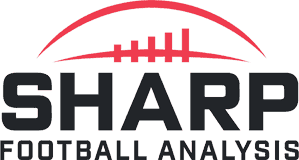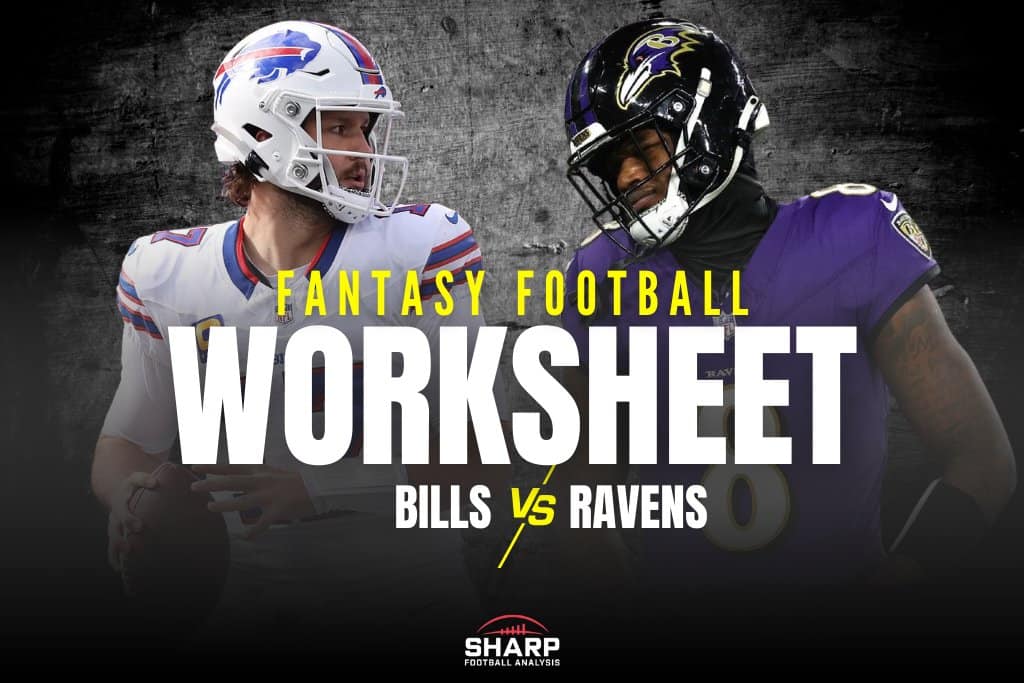The Worksheet, a comprehensive fantasy football preview by Rich Hribar, breaks down everything you need to know about the Week 1 matchup between the Bills and Ravens on Sunday Night Football.
Find a breakdown of every Week 1 NFL game in our Worksheet Hub.
| Baltimore | Rank | @ | Buffalo | Rank |
|---|---|---|---|---|
| 1.0 | Spread | -1.0 | ||
| 24.75 | Implied Total | 25.75 | ||
| 30.1 | 3 | Points/Gm | 30.6 | 2 |
| 21.2 | 8 | Points All./Gm | 21.6 | 12 |
| 62.3 | 17 | Plays/Gm | 61.2 | 19 |
| 61.4 | 12 | Opp. Plays/Gm | 60.7 | 8 |
| 6.8 | 1 | Off. Yards/Play | 5.9 | 6 |
| 5.2 | 6 | Def. Yards/Play | 5.6 | 25 |
| 53.55% | 2 | Rush% | 49.26% | 4 |
| 46.45% | 31 | Pass% | 50.74% | 29 |
| 36.88% | 2 | Opp. Rush % | 42.59% | 13 |
| 63.12% | 31 | Opp. Pass % | 57.41% | 20 |
- The Ravens (74.2%) and the Bills (71.6%) were first and second in the league in touchdown rate inside the red zone in 2024.
- 76.5% of Baltimore games in 2024 went over the game total, tied for the highest rate in the league.
- The Bills scored 18.1 more touchdowns than expected based on the league’s base output last season. That rate was the third-most touchdowns scored over expectations since 2010.
- The Bills (4.6%) and Ravens (6.1%) ranked second and third in the league in lowest turnover rate per drive in 2024.
- Buffalo forced a turnover on a league-high 17.5% of opponent drives.
- The Ravens led the NFL in rate of plays to gain 10 or more yards (25.1%) and 20 or more yards (8.1%) in 2024.
- Baltimore rushed for 1,828 more yards than their opponents in 2024, the most significant differential for a team in the 2000s.
- The Ravens averaged 2.2 more yards per rush than their opponents last season. The next closest team averaged 1.0 more yards per rush than their opponents.
Trust = spike production for that player
Quarterback
Josh Allen: Allen was excellent again last season, winning his first MVP Award.
Allen averaged only 233.2 passing yards per game (his fewest since 2019), but he made up ground in efficiency, ball protection, and rushing production.
Allen’s 7.7 yards per pass attempt were his highest since 2020, while his 12.2 yards per completion were his highest since his rookie season.
His 1.2% interception rate and 2.8% sack rate were career lows.
Allen posted a 5.8% touchdown rate as a passer, his fifth consecutive season with a touchdown rate of 5% or higher.
No other quarterback in the league can make that claim.
Allen also rushed for 531 yards and 12 touchdowns.
Buffalo has adopted their version of the “Tush Push,” which has ramped up Allen’s touchdown production on the ground.
He already had 6 or more rushing scores in each of his first five seasons in the league, but that has spiked to 27 rushing touchdowns over the past two years thanks to 11 one-yard rushing touchdowns, which is second in the NFL over the past two seasons.
Allen led the league in fantasy points scored in the red zone (168.7).
He has led the league in red zone fantasy points three times over the past four seasons and has not finished lower than second in that department in each of the past five years.
If there is one small sliver of shade to poke here, it is that Allen has been more dependent on his touchdown efficiency (both passing and rushing) as the passing volume for the Bills has decreased under Joe Brady.
Allen has been below 15 passing points per game in each of the past two seasons.
Buffalo had a 56.3% dropback rate (25th) last season, the lowest rate of Allen’s career.
Buffalo was 2% below pass rate expectations last season, the same rate they held in 2023 after Brady took over the offense (following a 5% over-expected performance before that point).
If that remains static, then Allen must sustain his lofty touchdown rates with both his arm and legs.
There is little doubt he is a fantasy QB1, but is that a spot we can expect to lock him into a ceiling outcome?
The Ravens did give Allen issues last season.
In the two games against Baltimore, Allen threw for 6.2 yards and 5.8 yards per pass attempt.
Those took up two of his five lowest weeks in yards per attempt on the year.
He did not throw a touchdown pass in either game.
Baltimore's pass defense improved as the season went on last season.
Over their final eight games, the Ravens allowed a 60.3% completion rate (4th), 6.2 yards per attempt (2nd), and a league-low 2.7% touchdown rate.
They added Jaire Alexander and Malaki Starks on the back end, giving them plenty of ammunition at defensive back.
Baltimore played aggressively against Allen in the playoffs, playing man coverage on 48.5% of his dropbacks.
That was their second-highest rate of man coverage in a game last season.
Baltimore was able to get to Allen in both matchups, pressuring him on 38.6% of his dropbacks.
When they did get home on Allen in those games, he was 8 of 18 (44.4%) without a touchdown.
The Ravens also held Allen to 20 and 21 rushing yards in those two matchups, although Allen did have 2 rushing touchdowns in the second meeting.
Lamar Jackson: Jackson put together one of the best statistical seasons from a quarterback in 2024.
As a passer, Jackson led the league with an 8.6% touchdown rate, 8.8 yards per attempt, a 119.6 rating, and a 77.5 QBR.
That touchdown rate, rating, and QBR were the highest for a passer since 2020.
His 0.31 EPA per dropback was the best rate for a quarterback since 2019, which was also him.
Jackson threw a career-high 41 touchdown passes to just 4 interceptions.
If that wasn’t enough, he added 915 yards and 4 touchdowns rushing.
Jackson has taken off and reclaimed his MVP-level status the past two seasons under Todd Monken.
Under Monken, Jackson has been the best version of himself as a passer, which is a scary proposition.
He has been the QB3 and QB1 in fantasy points per game the past two seasons with an increased passing efficiency.
Jackson has averaged 14.3 and 18.9 passing points per game the past two seasons after posting 13.1, 12.8, and 11.9 passing points per game over the 2020 to 2022 seasons.
While Jackson has been at his best under Monken, how much better can he be in 2025 compared to last year?
Jackson’s 8.6% touchdown rate is not something we can count on rolling over.
He threw 14.3 passing touchdowns over expectations, the most in the league.
61.4% (27 of 44) of his throws into the end zone resulted in touchdowns, the second-highest rate of the 2000s.
The league rate on those throws was 38.2%.
Jackson scored a gaudy 89.9 more fantasy points in the red zone than baseline expectations based on down and distance.
He led all players in red zone scoring despite ranking 15th in expected points at his position.
He did that while not having a single rushing attempt inside the five-yard line for the first time in his career.
We have discussed this before, but the word “regression” is not a complete boogeyman in this space and something we need to run away from.
Sean McDermott had a tale of two games against Jackson last year.
When these teams hooked up early in the season, Jackson went 13 of 18 (72.2%) for 156 yards (8.7 Y/A) with 2 touchdowns, rushing six times for 54 yards and a touchdown.
The Bills were highly passive in the first matchup.
They blitzed Jackson on 25% of his snaps, his fourth-lowest rate in a game this season.
They only played man coverage on 16.0% of their snaps.
They were in Cover 4 41.7% of the time.
Jackson saw quarters at a higher rate in just one other game this season.
Against Cover 4 last year, Jackson threw for 9.2 yards per attempt (third) with a league-high 131.2 passer rating.
The only times teams had limited success against Jackson in 2024 were when they aggressively sent man blitzes.
Even then, the success has been fleeting, but Jackson slaughtered passive defensive tendencies.
No quarterback had a higher rating against zone coverage in 2024 than Jackson (124.9).
He completed 72.8% of his passes for a league-high 10.0 yards per attempt against zone coverages and threw a league-high 20 touchdowns.
When he was not blitzed, Jackson led the NFL with 8.9 yards per attempt, throwing 30 touchdowns to just one interception.
But against man blitzes, Jackson was mortal.
He threw for 6.5 yards per attempt against man blitzes (26th).
When these teams hooked back up in the playoffs last year, McDermott calibrated.
The Bills ran man coverage on 42.4% of the snaps, their highest rate of the season.
They blitzed Jackson on 38.7% of his dropbacks, their second-highest rate in a game all of 2024.
On those man blitzes in the playoffs, Jackson was 3 of 9 for 39 yards (2.4 Y/A) with an interception.
When the Bills did not blitz and dropped back into zone coverage, Jackson was 10 of 10 for 122 yards (12.2 Y/A) with 2 touchdowns.
How McDermott calls this game could be the determining factor in Jackson’s output as a fantasy QB1 or the QB1 overall.
Running Back
Derrick Henry: Henry had a remarkable 2024 season, racking up 2,114 yards and 18 touchdowns.
Playing with the best collection of offensive talent in his career and Lamar Jackson commanding attention at all times allowed Henry new advantages.
He had a career-high 57.4% of his runs last season from the shotgun, where he led the league with 6.3 yards per rush.
He faced a light box on a career-high 20.6% of his runs, where he averaged 6.4 yards per rush (RB6).
As a result of those two points, he averaged a career-high 2.41 yards before contact per rush.
13.8% of his runs went for 10 or more yards, his highest rate since 2019.
He had more runs of 20 or more yards (19) than Saquon Barkley, with the most yards in the league on those gains (701).
His 46.2% success rate as a runner was his highest since his rookie season.
Henry combined a career-high 59 red zone touches with a career-high 18 touches from inside the five-yard line.
He decimated the Bills in their first matchup last season, rushing 24 times for 199 yards and 2 touchdowns.
He also caught a touchdown in that game.
In the playoff matchup, Buffalo performed slightly better, but Henry still rushed 16 times for 84 yards and a touchdown.
The Bills had their issues slowing down the run last season, allowing 4.4 YPC to backfields (22nd).
They allowed 1.47 yards before contact per rush (23rd).
Buffalo has a lighter defensive line and inherently wants to play an extra defensive back as their base defense under McDermott.
No team has played more snaps last season with five or more defensive backs on the field than the Bills (58.1 per game).
When the Ravens can utilize their base offense, they can push Buffalo out of that personnel.
The question entering Week 1 is will Baltimore be able to utilize those sets.
Isaiah Likely is already out with a knee injury while Patrick Ricard is dealing with a calf injury.
Likely being out could lead to fewer 2TE sets on Sunday.
If Ricard cannot play, that is a big deal for Baltimore forcing Buffalo to play against heavy sets.
With Ricard on the field against the Bills last season, Henry rushed 33 times for 252 yards (7.6 YPC) with two touchdowns.
He produced a first down or touchdown on 36.4% of those runs.
He only had seven runs with Ricard off the field against Buffalo, turning those into 31 yards (4.4 YPC) with a first down or score on 14.3%.
Henry ultimately ends up as a game-script sensitive RB1.
The best chance of slowing down Henry was to put the Ravens in a passing game script, which was no easy task.
The Ravens ran the ball 62.6% of the time with Henry on the field.
The only running back with a higher run rate per snap was Audric Estime (64.2%), who played 470 fewer snaps than Henry.
Henry averaged 130.9 rushing yards per game in Baltimore wins last season (on 20.9 rushes) while averaging 70.0 yards per game in losses (on 14.8 runs).
Henry has never been a high-reception player, but his 1.1 receptions per game were his fewest in a season since 2018.
The Bills did this in the second matchup, with Henry only having two fourth-quarter runs.
James Cook: Cook ended his third season turning 239 touches into 1,267 yards and 18 touchdowns.
He took a slight dip in usage from 2023 (16.5 touches per game) to last season (14.9 per game), which stemmed from a decrease in the passing game.
After 2.6 receptions for 26.2 yards per game in 2023, Cook caught 2.0 passes for 16.1 yards last season.
Cook only ran a route on 40.4% of the dropbacks in his games last season compared to 47.3% in 2023.
He made up for that loss of use in the passing game with touchdown equity.
Cook had only 9 touchdowns over his first two regular seasons before doubling that with 18 in 2024.
He scored a league-high 7.0 touchdowns over expectations.
He scored 4 touchdowns on rushes of 40 yards or more.
Cook finished sixth in red zone points despite ranking 16th in expectations.
Cook was tied for 13th in red zone touches (50) but managed to turn 14 of those into touchdowns (tied for fifth).
Paired with a usage dip, that makes Cook a tricky bet to sustain as a touchdown-based fantasy option, especially in this matchup.
The Ravens were dominant against the run in 2024.
They allowed a league-low 3.5 YPC to running backs, allowing a first down or touchdown on a league-best 15.6% of those runs.
In his two games against Baltimore last season, Cook rushed 26 times for 106 yards, catching 4 passes for 24 yards with 0 touchdowns.
Justice Hill: Hill had an effective season in a complementary role as a passing-down back last season, turning 89 touches into 611 yards and 4 touchdowns.
He caught 42 passes for 383 yards and 3 touchdowns.
While Hill is not more than a deep-league flyer in managed formats, he does have some single-game DFS appeal here.
Hill had games with 10 touches for 96 yards and 8 touches for 57 yards against Buffalo last season.
The Bills allowed not only rushing production to backs but were among the most giving defenses to backs out of the backfield.
Buffalo allowed a league-high 11.9 receiving points per game to running backs in 2024.
Wide Receiver
Zay Flowers: After a productive rookie season, Flowers took a step forward in year two, catching 74 passes for 1,059 yards and 4 touchdowns.
It was the most yards a Baltimore wide receiver has had since Torrey Smith in 2013.
After averaging 11.1 yards per catch as a rookie, Flowers averaged 14.3 yards per catch last season.
Flowers averaged 2.27 yards per route (17th) and was targeted on 24.9% of his routes (22nd).
The only thing holding Flowers back is the top-down volume of the Baltimore passing game.
His 27.4 routes per game ranked him WR60, while his 6.8 targets per game ranked him WR36.
Perhaps the best (and maybe the most detrimental) way to lay out his usage issues was that Flowers finished as the WR38 in expected points per game (11.8) and the WR35 in points per game (12.3) in a season in which his quarterback led the NFL in touchdown passes (41) and yards per pass attempt (8.8).
Even attached to the most efficient quarterback in the league, he was held back by his lack of top-down volume and usage near the end zone.
Flowers ranked WR48 in red zone points and WR52 in expected points in a year Lamar Jackson went bonkers in the red zone.
Flowers had only 7 red zone targets (11.5% of the team total) and 5 end zone targets in the red zone (15.2%).
There is plenty of evidence that Flowers is a good and efficient player I want to bet on, but it also makes sense why he is handled as a floor-based WR3.
Flowers did not play in the playoff game against these teams, catching one pass for 10 yards in the Week 4 matchup.
Keon Coleman: Coleman will enter year two having failed to address questions about his potential limitations entering the league: his ability to separate and his versatility.
Coleman caught 29 of 57 (50.9%) targets for 556 yards and 4 touchdowns over 13 games as a rookie.
He averaged 19.2 yards per catch but was limited to playing as an outside field stretcher.
Coleman played 87.7% of his snaps out wide.
31.6% of his targets were 20 yards or more downfield.
The only receivers with as many targets as Coleman and a higher rate of deep targets were Alec Pierce (47.8%) and Demarcus Robinson (32.8%).
38.6% of his targets were go routes, second only to Mike Williams (41.2%).
That said, there were some positives.
When he was on the field, Coleman led the team with a 20.6% target share.
He had a team-high 32% of the team's end zone targets when he was available.
Despite missing four games, Coleman had a team-high 8 end zone targets.
Against man coverage, Coleman was targeted 27.5% of his routes compared to 13.4% against zone coverage.
No team saw more man coverage last season than the Bills (35.5% of passing plays).
When Coleman was targeted against man coverage, he led Buffalo with 2.06 yards per route and led the team in target rate.
Coleman had plenty of issues against zone, drawing a target on only 12% of his routes with 1.60 yards per route.
The Ravens played man coverage on 34.3% of the dropbacks against Buffalo last season, but Coleman found little success in either of these outings.
After catching 3 of 4 targets for 51 yards in the Week 4 matchup, Coleman only had 1 catch for 5 yards in the postseason matchup.
Baltimore improved at defensive back this offseason, making things more challenging this go around.
Coleman is a touchdown-dependent FLEX.
Khalil Shakir: Shakir had his best season of his early career, catching 76 of 100 targets for 821 yards and 4 touchdowns.
Although he was held to fewer than 40 yards receiving in four of his final five games of the year, Shakir was the lone constant wide receiver in this offense in terms of target opportunities.
He led the team with 20.2% of the targets and was targeted on 26.3% of his routes, second on the team behind Dalton Kincaid.
He had 43 more targets than the next closest wide receiver on the roster.
His performance earned a four-year contract that put Shakir on the books through 2029.
The downside is that he may be limited in route participation due to playing 70% of his snaps from the slot.
Shakir has run 29 routes the past two seasons in one or two WR sets, 9.4% of the team’s dropbacks.
The other downside is that we have yet to see Shakir push for touchdown production.
Despite playing on the team that scored the most touchdowns over expectations last season, Shakir ranked WR53 in expected red zone points and was the WR50 in actual output.
Shakir had just 13.8% of Buffalo's red zone targets and received just 1 of the 25 end zone targets that the team had in the red zone.
He had only 3 end zone targets last season and has had only 5 through three seasons.
Shakir also missed the entire preseason due to an ankle injury.
He is practicing and expected to play in Week 1, but returning from that layoff could lead to a slower start.
This is not an appealing matchup for upside, either, leaving Shakir as a floor-based WR3/FLEX in full-PPR formats.
In two games against Baltimore last year, Shakir had games of 4-62-0 and 6-67-0.
Rashod Bateman: Bateman is coming off the best season of his career, catching 45 passes for 756 yards and 9 touchdowns.
That earned him a three-year contract extension this offseason.
Big plays were Bateman’s game in 2024.
He averaged 16.8 yards per catch (10th) with all of those scores.
However, he also had only 72 targets.
His 4.2 targets per game ranked 76th at the position.
His 2.7 receptions per game ranked 72nd.
Bateman’s output is the most dependent on those scores.
30.9% of Bateman’s points came via touchdowns, the highest rate of any top-40 scorer.
He averaged 4.4 points per game in his weeks without a touchdown.
He does carry some lower-end contingency upside here with Isaiah Likely out, but Bateman is a touchdown-based WR4/FLEX.
With Likely off the field last season, Bateman accounted for 16.9% of the team's targets, averaging 2.26 yards per route.
Josh Palmer: Buffalo signed Palmer to a three-year contract this offseason.
Palmer has not filled the box score with counting stats over his rookie contract, averaging 3,1 receptions for 39.4 yards per game over his four seasons with the Chargers.
He could not jump Quentin Johnston last season, catching 39 passes for 584 yards and 1 touchdown.
That said, Palmer does have underlying metrics that keep the door open for future production in Buffalo.
Palmer ranked 10th among qualifying receivers in route win rate last year.
The next-closest Buffalo wide receiver was Amari Cooper, who was 61st and no longer with the team.
Palmer also gives Buffalo another potential man-coverage beating option, something that is relevant since no team faced more man coverage than the Bills last year (35.5% of pass plays).
Palmer was eighth among wide receivers in separation score against man coverage.
Could Palmer be this year’s version of Bateman?
He is best left for single-game DFS while we find that out early in the season, while this individual matchup is not appealing for chasing more than a touchdown opportunity.
DeAndre Hopkins: The Ravens added Hopkins in free agency, who, at this stage, is more of a package player.
Hopkins will turn 33 this June, coming off a lackluster run with the Chiefs to close 2024.
Hopkins averaged a career-low 10.9 yards per catch last season with a career-low 38.1 yards per game.
Baltimore is not a heavy 3WR offense, so Hopkins will most likely be insurance and can make an impact in the red zone.
The Ravens were in 11 personnel on a league-low 28.1% of their snaps last season.
That rate was way down from the 47.2% rate in 2023 in Monken’s first season, but even that rate was 29th in the league.
We should see them get closer to that 2023 rate on Sunday due to the absence of Isaiah Likely, giving Hopkins a pulse as a touchdown dart to throw in single-game DFS.
Tight End
Mark Andrews: 2024 started as a disaster for Andrews.
He only caught 6 passes for 66 yards over the opening four games, receiving 9 total targets.
After a slow start to the season, Andrews found his footing in the offense.
From Week 5 on, Andrews was 10th among tight ends in receptions (49), sixth in receiving yards (608), and first in touchdowns (11) while ranking 15th in targets (60).
He had only 57 fewer yards than Travis Kelce over that span.
Kelce had 52 more targets.
Over that stretch of the season, Andrews was third among tight ends in yards per route run (2.21), trailing only George Kittle (2.84) and Trey McBride (2.28).
You could also call Andrews a part-time wide receiver instead of a tight end.
He only played 19% of his snaps in-line while playing 51.5% of his snaps in the slot and a position-high 26.1% lined up out wide.
He was still efficient and scored a lot of touchdowns, but Andrews ran a route on 65.8% of the dropbacks in his games last season, his lowest rate since 2019.
That is not a concern for Andrews opening the year since Isaiah Likely is not expected to play in Week 1 due to a fractured foot.
In the one game that Likely missed last year, Andrews set season highs in snaps (87.3%) and route rate (94.4%), catching 6 of 7 targets for 68 yards and a touchdown.
It was one of only three games in which he received more than 6 targets.
When Likely was off the field, Andrews was targeted on 21.7% of his routes.
That gives Andrews a jolt as a TE1 option in Week 1.
He is the Baltimore pass catcher I have the most faith in here, but this is no free square.
Buffalo was a stingy defense against tight ends in 2024.
They allowed 6.3 yards per target (6th) and a 3.9% touchdown rate (13th) to the position.
That was with Matt Milano missing most of the season.
Andrews will get a chance to exercise some demons from how last year ended in Buffalo.
Andrews caught 5 of 7 targets for 61 yards when these teams played in the postseason last year, losing a fumble and dropping a potential touchdown to end the game.
Dalton Kincaid: It was a disappointing 2024 season for Kincaid.
After averaging 4.6 receptions for 42.1 yards per game as a rookie, he averaged 3.4 receptions for 34.5 yards over 13 games last season.
Kincaid’s season high was 53 yards, and he finished with fewer than 50 yards in 10 outings.
He was targeted on a team-high 27.2% of his routes last season and was second at the position with 30.9% of the Buffalo targets when he was on the field.
The rub was that he only ran a route on 62.9% of the dropbacks in his games.
During the season, Kincaid missed four games due to a concussion, a collarbone injury, and a knee injury.
Those injuries may have contributed to his reduced snaps when active, but the Bills were also another low-volume passing offense that featured another tight end who was active in the run game.
The Bills were 28th in the NFL in dropbacks per game (33.9).
Buffalo ran the ball only 36% of the time with Kincaid in the game, compared to a 45.1% rate with Dawson Knox.
As a result, Kincaid did not play near the end zone.
Through two NFL seasons, Kincaid has had only 7 targets in the end zone.
When Kincaid was running routes, he was used in a feast or famine role.
After 11% of his targets were at or behind the line of scrimmage as a rookie, that rate spiked to 22% last season.
Oddly enough, his deep targets went up, however.
After a 7.7% deep target rate in 2023, that rate was 14.7% last season.
The problem is that he only caught 2 of 11 deep targets.
20% of Kincaid’s targets were inaccurate.
The Bills still have a limited wide receiver room on paper, and Kincaid is healthy, which is a positive in his favor, but we need the passing volume to increase and Kincaid’s role to expand near the end zone.
He is a TE2 entering the season.
In his two games against the Ravens last year, Kincaid had 6 total catches for 58 yards.

More Week 1 Fantasy Breakdowns From The Worksheet:
| Matchup | Time |
|---|---|
| Cowboys @ Eagles -- FREE | NFL Kickoff Game |
| Chiefs vs. Chargers -- FREE | Friday Night Football |
| Bucs @ Falcons | Sunday -- 1 p.m. ET |
| Bengals @ Browns | Sunday -- 1 p.m. ET |
| Dolphins @ Colts | Sunday -- 1 p.m. ET |
| Raiders @ Patriots | Sunday -- 1 p.m. ET |
| Cardinals @ Saints | Sunday -- 1 p.m. ET |
| Steelers @ Jets | Sunday -- 1 p.m. ET |
| Giants @ Commanders | Sunday -- 1 p.m. ET |
| Panthers @ Jaguars | Sunday -- 1 p.m. ET |
| Titans @ Broncos | Sunday -- 4:05 p.m. ET |
| 49ers @ Seahawks | Sunday -- 4:05 p.m. ET |
| Lions @ Packers | Sunday -- 4:25 p.m. ET |
| Texans @ Rams | Sunday -- 4:25 p.m. ET |
| Ravens @ Bills -- FREE | Sunday Night Football |
| Vikings @ Bears -- FREE | Monday Night Football |


















